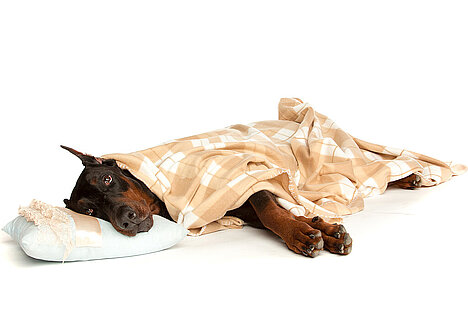Elbow dysplasia

Elbow dysplasia is a disease that affects the elbow joints of dogs. It can lead to pain, lameness and osteoarthritis. In this blog post you will find out what elbow dysplasia is, how it develops, how it is diagnosed and treated and how you can prevent it.
What is elbow dysplasia?
Elbow dysplasia is a collective term for various developmental disorders of the elbow joint. The elbow joint consists of three bones: the upper arm bone (humerus), the ulna bone (ulna) and the radius bone (radius). These bones must fit together perfectly for the joint to function smoothly. In elbow dysplasia, there is a malformation or uneven growth of the bones or cartilage, which leads to instability or wear and tear of the joint.
How does elbow dysplasia develop?
The exact causes of elbow dysplasia are not yet fully understood. However, there are some factors that can increase the risk, such as
- Genetics: elbow dysplasia is a hereditary condition that is most common in large and heavy dog breeds, such as Bernese Mountain Dogs, German Shepherds, Golden Retrievers or Labrador Retrievers. However, smaller breeds can also be affected, such as beagles and French bulldogs.
- Diet: Too high or too low a calorie intake, a deficiency or excess of certain nutrients such as calcium or phosphorus can affect bone growth and lead to malformations.
- Exercise: Too much or too little exercise can also interfere with bone growth. Too much exercise can lead to overloading of the joint, while too little exercise can lead to weakening of the muscles and ligaments.
How is elbow dysplasia diagnosed?
If you notice signs of elbow dysplasia in your dog, you should consult a vet. Symptoms can vary depending on the severity and the joint affected, but typical signs include
- Lameness or limping on one or both front legs
- tenderness or stiffness when touching or moving the elbow
- Swelling or thickening of the elbow
- Limited mobility or cracking noises in the elbow
The vet will perform a clinical examination and take an X-ray of the elbow to confirm the diagnosis. In some cases, a computed tomography (CT) scan or magnetic resonance imaging (MRI) may also be necessary to assess the structures of the joint in more detail.
How is elbow dysplasia treated?
The treatment of elbow dysplasia depends on the age, health condition and severity of the disease. There are two treatment options: conservative or surgical.
Conservative treatment aims to relieve pain and reduce inflammation. This includes:
- Painkillers and anti-inflammatory medication
- Weight reduction for overweight dogs
- Adapting the diet to the dog's needs
- Physiotherapy and exercise therapy
- Joint protection with bandages or orthoses
Surgical treatment is aimed at eliminating the cause of elbow dysplasia and improving the function of the joint. This includes
- Arthroscopy: a minimally invasive operation in which a small camera is inserted into the joint to assess the cartilage and remove damaged parts.
- Osteotomy: An operation in which part of the bone is cut and realigned to improve the fit of the joint.
- Joint replacement: An operation in which the entire joint is replaced with an artificial prosthesis.
How can elbow dysplasia be prevented?
Elbow dysplasia is a condition that is not always preventable. However, there are some measures you can take to reduce the risk or alleviate the symptoms, such as
- Buy a dog from a reputable breeder who has tested the parent animals for elbow dysplasia and can provide you with the relevant certificates.
- Feed your dog a high-quality diet that is appropriate for his size, age and activity level. Avoid overfeeding or supplements without veterinary advice.
- Provide your dog with sufficient exercise, but avoid extreme exertion or jumping. Make sure your dog does not walk on slippery or hard surfaces.
- Have your dog examined regularly by a vet and look out for signs of elbow dysplasia. The earlier the condition is detected, the better the chances of treatment.
The authors assume that a veterinarian should be consulted if an animal is ill and that medication should only be taken after consultation with a doctor or pharmacist. Only an individual examination can lead to a diagnosis and treatment decision.
We help you find the nearest vet → This way